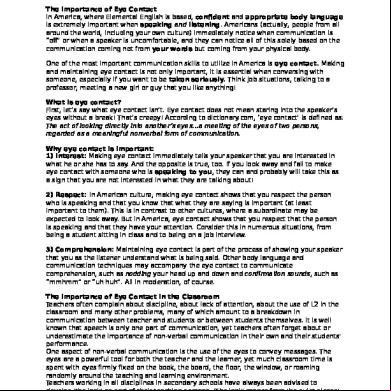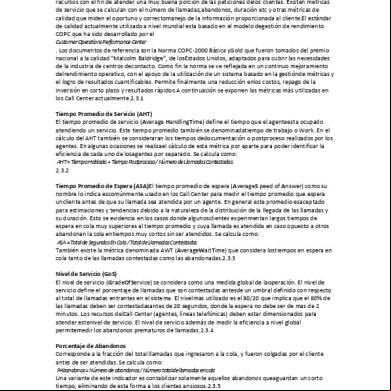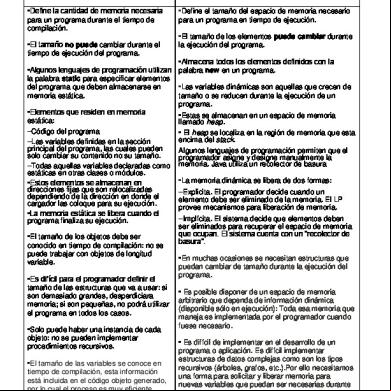Eye 422e31
This document was ed by and they confirmed that they have the permission to share it. If you are author or own the copyright of this book, please report to us by using this report form. Report 3b7i
Overview 3e4r5l
& View Eye as PDF for free.
More details w3441
- Words: 1,142
- Pages: 2
Eye The Importance of Eye In America, where Elemental English is based, confident and appropriate body language is extremely important when speaking and listening. Americans (actually, people from all around the world, including your own culture) immediately notice when communication is “off” or when a speaker is uncomfortable, and they can notice all of this solely based on the communication coming not from your words but coming from your physical body. One of the most important communication skills to utilize in America is eye . Making and maintaining eye is not only important, it is essential when conversing with someone, especially if you want to be taken seriously. Think job situations, talking to a professor, meeting a new girl or guy that you like anything! What is eye ? First, let’s say what eye isn’t. Eye does not mean staring into the speaker’s eyes without a break! That’s creepy! According to dictionary.com, ‘eye ’ is defined as: The act of looking directly into another’s eyes…a meeting of the eyes of two persons, regarded as a meaningful nonverbal form of communication. Why eye is important: 1) Interest: Making eye immediately tells your speaker that you are interested in what he or she has to say. And the opposite is true, too. If you look away and fail to make eye with someone who is speaking to you, they can and probably will take this as a sign that you are not interested in what they are talking about! 2) Respect: In American culture, making eye shows that you respect the person who is speaking and that you know that what they are saying is important (at least important to them). This is in contrast to other cultures, where a subordinate may be expected to look away. But in America, eye shows that you respect that the person is speaking and that they have your attention. Consider this in numerous situations, from being a student sitting in class and to being on a job interview. 3) Comprehension: Maintaining eye is part of the process of showing your speaker that you as the listener understand what is being said. Other body language and communication techniques may accompany the eye to communicate comprehension, such as nodding your head up and down and confirmation sounds, such as “mmhmm” or “uh huh”. All in moderation, of course. The Importance of Eye in the Classroom Teachers often complain about discipline, about lack of attention, about the use of L2 in the classroom and many other problems, many of which amount to a breakdown in communication between teacher and students or between students themselves. It is well known that speech is only one part of communication, yet teachers often forget about or underestimate the importance of non-verbal communication in their own and their students' performance. One aspect of non-verbal communication is the use of the eyes to convey messages. The eyes are a powerful tool for both the teacher and the learner, yet much classroom time is spent with eyes firmly fixed on the book, the board, the floor, the window, or roaming randomly around the teaching and learning environment. Teachers working in all disciplines in secondary schools have always been advised to develop 'the look' as part of their teaching persona. 'The look' ranges from 'be quiet please',
through 'I'm not going to tell you again' to 'don't mess with me, sonny', and in this respect is seen as having a disciplinary function. Meanwhile, the business world has accepted eye as an important component of achieving success in giving presentations and improving rapport between representative and client, while these days it is possible to find many websites offering advice on how to forge personal relationships through the judicious use of eye . Researchers and practitioners in Neuro-Linguistic Programming (NLP) have brought the notion of body language and eye back to the attention of language teachers, but largely in the context of providing clues to the nature of the learner rather than in of a teaching tool. Here are some of the things that we have been reminded of or learnt anew:
'The look' still works, but don't overdo it or you will become a caricature of yourself. Establishing a management role in the classroom involves eye from the outset. Be in your classroom before your learners, and welcome them individually with a combination of eye and their name as they enter the room. Talk to your learners, not to the book, the board or the screen. Eyes can set the tone of a lesson. As the lesson starts, walk around the room looking to check whether the learners are ready -- books out, pens and paper handy, mobile phones off. If not, eye should suffice to rectify the situation. Try teaching part of a lesson without saying anything. This should remind you of how important paralinguistic is as well as helping to control your teacher talking time. Good eye does not mean staring or gazing. Many learners are likely to find this uncomfortable and consequently avert their own eyes and lose concentration. Neither does good eye mean eyes darting from learner to learner around the room -- this has no effect whatsoever. It is recommended that there should be three to five seconds eye for non-verbal communication to take place. Watch your learners as well as listen to them, particularly while they are performing tasks. Look for signs of being bored or being lost. Encourage your learners to make eye while they are working together in pairs or groups. Start by training them to listen to each other using non-verbal responses only. Research shows that there is a strong link between the amount of eye people receive and their degree of participation in group communication -- in the number of turns taken in a group conversation for example. The NLP approach to eye is holistic and individualistic, but is soundly based on the premise that good eye increases rapport. Save time and effort with specific messages delivered by eye and facial expression. Show praise, encouragement often, and disapproval occasionally. Remind learners that they ought to know an answer or that they could provide a response if they tried. Use eye as a correction technique. Nominate and invite responses by eye. If the nominee is not watching, someone will give him/her a nudge. Eye is, fundamentally, time and effort saving.
Much of the above is likely to seem transparently obvious, only natural, and an aspect of human behavior either innate or developed over time. But watch yourself, watch your colleagues, and watch your learners! Resources: http://iteslj.org/Techniques/Darn-Eye.html http://www.elementalenglish.com/the-importance-of-eye-/
through 'I'm not going to tell you again' to 'don't mess with me, sonny', and in this respect is seen as having a disciplinary function. Meanwhile, the business world has accepted eye as an important component of achieving success in giving presentations and improving rapport between representative and client, while these days it is possible to find many websites offering advice on how to forge personal relationships through the judicious use of eye . Researchers and practitioners in Neuro-Linguistic Programming (NLP) have brought the notion of body language and eye back to the attention of language teachers, but largely in the context of providing clues to the nature of the learner rather than in of a teaching tool. Here are some of the things that we have been reminded of or learnt anew:
'The look' still works, but don't overdo it or you will become a caricature of yourself. Establishing a management role in the classroom involves eye from the outset. Be in your classroom before your learners, and welcome them individually with a combination of eye and their name as they enter the room. Talk to your learners, not to the book, the board or the screen. Eyes can set the tone of a lesson. As the lesson starts, walk around the room looking to check whether the learners are ready -- books out, pens and paper handy, mobile phones off. If not, eye should suffice to rectify the situation. Try teaching part of a lesson without saying anything. This should remind you of how important paralinguistic is as well as helping to control your teacher talking time. Good eye does not mean staring or gazing. Many learners are likely to find this uncomfortable and consequently avert their own eyes and lose concentration. Neither does good eye mean eyes darting from learner to learner around the room -- this has no effect whatsoever. It is recommended that there should be three to five seconds eye for non-verbal communication to take place. Watch your learners as well as listen to them, particularly while they are performing tasks. Look for signs of being bored or being lost. Encourage your learners to make eye while they are working together in pairs or groups. Start by training them to listen to each other using non-verbal responses only. Research shows that there is a strong link between the amount of eye people receive and their degree of participation in group communication -- in the number of turns taken in a group conversation for example. The NLP approach to eye is holistic and individualistic, but is soundly based on the premise that good eye increases rapport. Save time and effort with specific messages delivered by eye and facial expression. Show praise, encouragement often, and disapproval occasionally. Remind learners that they ought to know an answer or that they could provide a response if they tried. Use eye as a correction technique. Nominate and invite responses by eye. If the nominee is not watching, someone will give him/her a nudge. Eye is, fundamentally, time and effort saving.
Much of the above is likely to seem transparently obvious, only natural, and an aspect of human behavior either innate or developed over time. But watch yourself, watch your colleagues, and watch your learners! Resources: http://iteslj.org/Techniques/Darn-Eye.html http://www.elementalenglish.com/the-importance-of-eye-/










